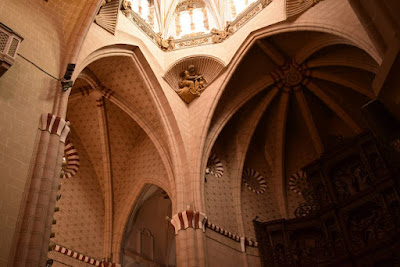Teruel is where we left the motorway to travel the 20 miles inland to Albarracin, but Teruel is a destination in its own right.
It has a history stretching back to pre-Roman times, in
fact, the Romans destroyed the city as a reprisal. It was a Moorish stronghold
after the 8th Century and later architecture reflects the Moors’
influence long after they were deposed: it’s called Mudejar style.
The cathedral, dating from the 13th century,
shows this mixture of Christian and Islamic influence. The cathedral bell tower
which could comfortably fit into any Arab city.
Inside, it’s mostly traditionally European Spanish, with
amazingly ornate decoration everywhere. Just look at this domed ceiling.
And the intricacy
of these wood carvings! The photo is but a small part of a huge floor to
ceiling work behind the main altar.
Now we’re back
again to Islamic design, with an incredibly detailed ceiling. The photo is
quite inadequate.
We’ll leave the
intensity of the cathedral after a final look at how the two styles combined to
produce these most elegant arches.
The city itself feels
very Spanish, with squares, pavement cafes and bars. There don’t appear to be
many foreign visitors as we all stand out like sore thumbs so can't be missed.
Even the manhole covers display a certain elegance. Tempting to bring one back to replace the dour Anglia Water manhole cover from which our garden is regularly flooded.
Running into the
old quarter is a 600 year old aqueduct, of course, not functioning any more.
The above photo was
taken from an unusual small public garden where the plants were displayed
vertically, set in a moisture-retaining type of felt. Jane was very impressed,
but I’m not sure how our version is going to look back in our garden in Hartford!
Teruel is a middle
of the road city, rather than a primary tourist destination, so it has plenty
of typical Spanish establishments like this bar.
The city’s recent
history is more tragic. It occupied a strategic position in the Spanish Civil
War and a bitter battle was fought during the winter of 1937 – 1938. It was a
record cold winter, with 4 feet of snow and temperatures dropping to -18C. Each
side suffered over 100,000 casualties but finally Franco’s army triumphed
having superior weapons and supplies – and not inconsiderable help from Nazi
Germany.
We headed back to
Albarracin for our final evening before leaving. On the way back, Teruel
airport grabs our attention as it’s full of parked planes. It seems the airport
is used by fleet operators who park out-of-service planes, presumably at low
cost. The photo only shows a few of the many aircraft as it’s difficult to the
right angle from the road.
Leaving the
airport, the road follows the twisty river back to Albarracin. It’s a pretty
run, on well surfaced roads. In many places the scenery is more dramatic, but
there’s nowhere to stop to photograph. More excuses!
We have enjoyed our
visit to this area, and tomorrow we’re bound for the Pyrenees Ordesa National
Park, just on the Spanish side of the border with France.













No comments:
Post a Comment